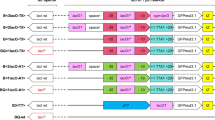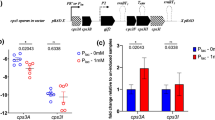Abstract
DNA regions that flank a gene’s promoter play an important role in determining transcription efficiency by interacting with the carboxy-terminal domain of RNA polymerase α-subunit. We placed an adenine-rich upstream element (UP) between −38 and −59 of the core trc promoter to enhance gene expression in Ochrobactrum anthropi up to 66-fold. The high level of expression achieved by the UP element and the N-terminus fusion of a 6xHis epitope tag facilitated detection and purification of heterologous proteins directly from O. anthropi.




Similar content being viewed by others
References
Aiyar SE, Gourse RL, Ross W (1998) Upstream A-tracts increase bacterial promoter activity through interactions with the RNA polymerase alpha subunit. Proc Natl Acad Sci USA 95:14652–14657
Amann E, Brosius J, Ptashne M (1983) Vectors bearing a hybrid trp-lac promoter useful for regulated expression of cloned genes in Escherichia coli. Gene 25:167–178
Asano Y, Mori T, Hanamoto S, Kato Y, Nakazawa A (1989a) A new D-stereospecific amino acid amidase from Ochrobactrum anthropi. Biochem Biophys Res Commun 162:470–474
Asano Y, Nakazawa A, Kato Y, Kondo K (1989b) Properties of a novel D-stereospecific aminopeptidase from Ochrobactrum anthropi. J Biol Chem 264:14233–14239
Asano Y, Kato Y, Yamada A, Kondo K (1992) Structural similarity of D-aminopeptidase to carboxypeptidase DD and beta-lactamases. Biochemistry 31:2316–2328
Christenson JC, Pavia AT, Seskin K, Brockmeyer D, Korgenski EK, Jenkins E, Pierce J, Daly JA (1997) Meningitis due to Ochrobactrum anthropi: an emerging nosocomial pathogen. A report of 3 cases. Pediatr Neurosurg 27:218–221
Estrem ST, Gaal T, Ross W, Gourse RL (1998) Identification of an UP element consensus sequence for bacterial promoters. Proc Natl Acad Sci USA 95:9761–9766
Fanuel L, Thamm I, Kostanjevecki V, Samyn B, Joris B, Goffin C, Brannigan J, Van Beeumen J, Frere JM (1999) Two new aminopeptidases from Ochrobactrum anthropi active on D-alanyl-p-nitroanilide. Cell Mol Life Sci 55:812–818
Gard JK, Feng PC, Hutton WC (1997) Nuclear magnetic resonance timecourse studies of glyphosate metabolism by microbial soil isolates. Xenobiotica 27:633–644
Higgins CS, Avison MB, Jamieson L, Simm AM, Bennett PM, Walsh TR (2001) Characterization, cloning and sequence analysis of the inducible Ochrobactrum anthropi AmpC beta-lactamase. J Antimicrob Chemother 47:745–754
Laura D, De Socio G, Frassanito R, Rotilio D (1996) Effects of atrazine on Ochrobactrum anthropi membrane fatty acids. Appl Environ Microbiol 62:2644–2646
Lebuhn M, Achouak W, Schloter M, Berge O, Meier H, Barakat M, Hartmann A, Heulin T (2000) Taxonomic characterization of Ochrobactrum sp. isolates from soil samples and wheat roots, and description of Ochrobactrum tritici sp. nov. and Ochrobactrum grignonense sp. nov. Int J Syst Evol Microbiol 50(Pt 6):2207–2223
Lechner U, Baumbach R, Becker D, Kitunen V, Auling G, Salkinoja-Salonen M (1995) Degradation of 4-chloro-2-methylphenol by an activated sludge isolate and its taxonomic description. Biodegradation 6:83–92
Makrides SC (1996) Strategies for achieving high-level expression of genes in Escherichia coli. Microbiol Rev 60:512–538
Ogawa J, Takeda S, Xie SX, Hatanaka H, Ashikari T, Amachi T, Shimizu S (2001) Purification, characterization, and gene cloning of purine nucleosidase from Ochrobactrum anthropi. Appl Environ Microbiol 67:1783–1787
Schafer A, Konrad R, Kuhnigk T, Kampfer P, Hertel H, Konig H (1996) Hemicellulose-degrading bacteria and yeasts from the termite gut. J Appl Bacteriol 80:471–478
Seleem MN, Vemulapalli R, Boyle SM, Schurig GG, Sriranganathan N (2004) Improved expression vector for Brucella species. Biotechniques 37:740–744
Sonke T, Ernste S, Tandler RF, Kaptein B, Peeters WP, Van Assema FB, Wubbolts MG, Schoemaker HE (2005) L-selective amidase with extremely broad substrate specificity from Ochrobactrum anthropi NCIMB 40321. Appl Environ Microbiol 71:7961–7973
Vemulapalli R, He Y, Boyle SM, Sriranganathan N, Schurig GG (2000) Brucella abortus strain RB51 as a vector for heterologous protein expression and induction of specific Th1 type immune responses. Infect Immun 68:3290–3296
Yu WL, Lin CW, Wang DY (1998) Clinical and microbiologic characteristics of Ochrobactrum anthropi bacteremia. J Formos Med Assoc 97:106–112
Acknowledgements
We express our appreciation to Dr. Tim Larson of Virginia Tech for his critical reading of the manuscript and suggestions. We would like to thank Mrs. Kay Carlson of Virginia tech for providing us with O. anthropi strain and the support throughout the experiment.
Author information
Authors and Affiliations
Corresponding author
Rights and permissions
About this article
Cite this article
Seleem, M., Ali, M., Abd Al-Azeem, M.W. et al. High-level heterologous gene expression in Ochrobactrum anthropi using an A-rich UP element. Appl Microbiol Biotechnol 73, 1123–1127 (2007). https://doi.org/10.1007/s00253-006-0555-7
Received:
Revised:
Accepted:
Published:
Issue Date:
DOI: https://doi.org/10.1007/s00253-006-0555-7




